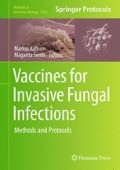Abstract
CD4+ T cells play a key role in host defense against many fungal infections. T cells are also implicated in vaccine immunity to fungi. To date, only a small number of fungal antigens have been identified. Knowing the antigenic determinants of fungi-specific T cells greatly facilitates the detection, enumeration and characterizes the antifungal T cells and it constitutes an important step toward the design and development of vaccination strategies. This chapter describes a method of MHC-II ligand elution and mass spectrometric analysis to identify naturally processed and presented fungal peptide epitopes.
Access this chapter
Tax calculation will be finalised at checkout
Purchases are for personal use only
References
Nanjappa SG, Heninger E, Wuthrich M, Gasper DJ, Klein BS (2012) Tc17 cells mediate vaccine immunity against lethal fungal pneumonia in immune deficient hosts lacking CD4+ T cells. PLoS Pathog 8:e1002771. doi:10.1371/journal.ppat.1002771
Cassone A, Casadevall A (2012) Recent progress in vaccines against fungal diseases. Curr Opin Microbiol 15:427–433. doi:10.1016/j.mib.2012.04.004
Schmidt CS, White CJ, Ibrahim AS, Filler SG, Fu Y, Yeaman MR et al (2012) NDV-3, a recombinant alum-adjuvanted vaccine for Candida and Staphylococcus aureus, is safe and immunogenic in healthy adults. Vaccine 30:7594–7600. doi:10.1016/j.vaccine.2012.10.038
Lemmel C, Stevanovic S (2003) The use of HPLC-MS in T-cell epitope identification. Methods 29:248–259
Hillen N, Stevanovic S (2006) Contribution of mass spectrometry-based proteomics to immunology. Expert Rev Proteomics 3:653–664. doi:10.1586/14789450.3.6.653
Bär E, Gladiator A, Bastidas S, Roschitzki B, Acha-Orbea H, Oxenius A et al (2012) A novel Th cell epitope of Candida albicans mediates protection from fungal infection. J Immunol 188:5636–5643. doi:10.4049/jimmunol.1200594
Nesvizhskii AI, Keller A, Kolker E, Aebersold R (2003) A statistical model for identifying proteins by tandem mass spectrometry. Anal Chem 75:4646–4658
Wuthrich M, Brandhorst TT, Sullivan TD, Filutowicz H, Sterkel A, Stewart D et al (2015) Calnexin induces expansion of antigen-specific CD4(+) T cells that confer immunity to fungal ascomycetes via conserved epitopes. Cell Host Microbe 17:452–465. doi:10.1016/j.chom.2015.02.009
Moon JJ, Chu HH, Pepper M, McSorley SJ, Jameson SC, Kedl RM et al (2007) Naive CD4(+) T cell frequency varies for different epitopes and predicts repertoire diversity and response magnitude. Immunity 27:203–213. doi:10.1016/j.immuni.2007.07.007
Perruccio K, Tosti A, Burchielli E, Topini F, Ruggeri L, Carotti A et al (2005) Transferring functional immune responses to pathogens after haploidentical hematopoietic transplantation. Blood 106:4397–4406. doi:10.1182/blood-2005-05-1775
Haque T, Wilkie GM, Taylor C, Amlot PL, Murad P, Iley A et al (2002) Treatment of Epstein-Barr-virus-positive post-transplantation lymphoproliferative disease with partly HLA-matched allogeneic cytotoxic T cells. Lancet 360:436–442. doi:10.1016/S0140-6736(02)09672-1
Papadopoulou A, Gerdemann U, Katari UL, Tzannou I, Liu H, Martinez C et al (2014) Activity of broad-spectrum T cells as treatment for AdV, EBV, CMV, BKV, and HHV6 infections after HSCT. Sci Transl Med 6:242ra83. doi:10.1126/scitranslmed.3008825
Peggs KS, Thomson K, Samuel E, Dyer G, Armoogum J, Chakraverty R et al (2011) Directly selected cytomegalovirus-reactive donor T cells confer rapid and safe systemic reconstitution of virus-specific immunity following stem cell transplantation. Clin Infect Dis 52:49–57. doi:10.1093/cid/ciq042
Steiner QG, Otten LA, Hicks MJ, Kaya G, Grosjean F, Saeuberli E et al (2008) In vivo transformation of mouse conventional CD8alpha+ dendritic cells leads to progressive multisystem histiocytosis. Blood 111:2073–2082. doi:10.1182/blood-2007-06-097576
Mommen GPM, Frese CK, Meiring HD, van Gaans-van den Brink J, de Jong APJM, van Els CACM et al (2014) Expanding the detectable HLA peptide repertoire using electron-transfer/higher-energy collision dissociation (EThcD). Proc Natl Acad Sci U S A 111:4507–4512. doi:10.1073/pnas.1321458111
Acknowledgments
We would like to thank Prof. Stefan Stevanović for technical advice and suggestions. Work in the LeibundGut-laboratory is supported by the Swiss National Science Foundation, the Gebert Rüf Foundation, the Promedica Foundation, and the University of Zürich.
Author information
Authors and Affiliations
Corresponding author
Editor information
Editors and Affiliations
Rights and permissions
Copyright information
© 2017 Springer Science+Business Media LLC
About this protocol
Cite this protocol
Roschitzki, B., LeibundGut-Landmann, S. (2017). Identification of Fungal T Cell Epitopes by Mass Spectrometry-Based Proteomics. In: Kalkum, M., Semis, M. (eds) Vaccines for Invasive Fungal Infections. Methods in Molecular Biology, vol 1625. Humana Press, New York, NY. https://doi.org/10.1007/978-1-4939-7104-6_5
Download citation
DOI: https://doi.org/10.1007/978-1-4939-7104-6_5
Published:
Publisher Name: Humana Press, New York, NY
Print ISBN: 978-1-4939-7103-9
Online ISBN: 978-1-4939-7104-6
eBook Packages: Springer Protocols

